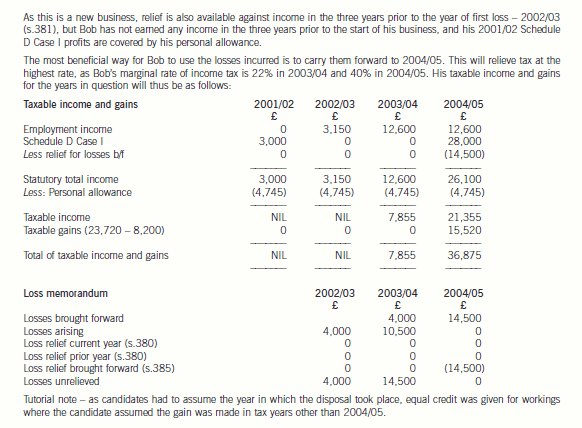acca考试P阶段的考试是机考还是笔试呢?
发布时间:2021-03-12
acca考试P阶段的考试是机考还是笔试呢?
最佳答案
从2020年3月起,ACCA协会在中国地区引入SP战略阶段的机考,同时,这些区域将不再提供纸质考试。这也标志着,自2021年起ACCA考试将在中国地区全面实施机考考试。
下面小编为大家准备了 ACCA考试 的相关考题,供大家学习参考。
(b) Assuming that the income from the sale of the books is not treated as trading income, calculate Bob’s taxable
income and gains for all relevant tax years, using any loss reliefs in the most tax-efficient manner. Your
answer should include an explanation of the loss reliefs available and your reasons for using (or not using)
them. (12 marks)
Assume that the rates and allowances for 2004/05 apply throughout this part of the question.


(c) In August 2004 it was discovered that the inventory at 31 December 2003 had been overstated by $100,000.
(4 marks)
Required:
Advise the directors on the correct treatment of these matters, stating the relevant accounting standard which
justifies your answer in each case.
NOTE: The mark allocation is shown against each of the three matters.
(c) The opening inventory should be included in the current year’s income statement at the corrected figure, and the opening
balance of retained profit reduced by $100,000. The $100,000 reduction will appear in the statement of changes in equity.
(IAS8 Accounting policies, changes in accounting estimates and errors)
(b) Discuss the key issues which the statement of cash flows highlights regarding the cash flow of the company.
(10 marks)
(b) Financial statement ratios can provide useful measures of liquidity but an analysis of the information in the cash flow
statement, particularly cash flow generated from operations, can provide specific insights into the liquidity of Warrburt. It is
important to look at the generation of cash and its efficient usage. An entity must generate cash from trading activity in order
to avoid the constant raising of funds from non-trading sources. The ‘quality of the profits’ is a measure of an entity’s ability
to do this. The statement of cash flow shows that the company has generated cash in the period despite sustaining a
significant loss ($92m cash flow but $21m loss). The problem is the fact that the entity will not be able to sustain this level
of cash generation if losses continue.
An important measure of cash flow is the comparison of the cash from operating activity to current liabilities. In the case of
Warrburt, this is $92m as compared to $155m. Thus the cash flow has not covered the current liabilities.
Operating cash flow ($92 million) determines the extent to which Warrburt has generated sufficient funds to repay loans,
maintain operating capability, pay dividends and make new investments without external financing. Operating cash flow
appears to be healthy, partially through the release of cash from working capital. This cash flow has been used to pay
contributions to the pension scheme, pay finance costs and income taxes. These uses of cash generated would be normal for
any entity. However, the release of working capital has also financed in part the investing activities of the entity which includes
the purchase of an associate and property, plant and equipment. The investing activities show a net cash outflow of
$43 million which has been financed partly out of working capital, partly from the sale of PPE and AFS financial assets and
partly out of cash generated from operations which include changes in working capital. It seems also that the issue of share
capital has been utilised to repay the long term borrowings and pay dividends. Also a significant amount of cash has been
raised through selling AFS investments. This may not continue in the future as it will depend on the liquidity of the market.
This action seems to indicate that the long term borrowings have effectively been ‘capitalised’. The main issue raised by the
cash flow statement is the use of working capital to partially finance investing activities. However, the working capital ratio
and liquidity ratios are still quite healthy but these ratios will deteriorate if the trend continues.
(c) State any reliefs Bob could claim regarding the fall in value of his shares in Willis Ltd, and describe how the
operation of any such reliefs could reduce Bob’s taxable income. (4 marks)
Relevant retail price index figures are:
September 1990 129·3
April 1998 162·6
December 2004 189·9
(c) Claims for capital losses
Where the value of shares (a chargeable asset) has become negligible (defined as <5% of the original cost), a claim can be
made to treat the asset as though it was sold and then immediately reacquired for its current market value. This is known as
a negligible value claim.
The sale and reacquisition is treated as taking place at the time that the claim is made or at a specified time (up to 2 years
before the start of the tax year in which the claim was made) if the asset was of negligible value at that time.
As the loss is on unquoted shares, a further relief (s.574 ICTA 1988) allows the loss to be relieved against the total income
of the taxpayer for the year in which the loss arose, and/or against the total income of the previous year.
Losses are first relieved against current year income, with any excess being available for offset against the prior year’s income.
Bob can therefore make a negligible value claim as at 1 December 2004. This will give rise to a loss of £14,500
(£500 – £15,000) which will be deemed to arise in the year 2004/05. By doing so, his taxable income for that year will be
reduced from £36,875 to £22,375.
声明:本文内容由互联网用户自发贡献自行上传,本网站不拥有所有权,未作人工编辑处理,也不承担相关法律责任。如果您发现有涉嫌版权的内容,欢迎发送邮件至:contact@51tk.com 进行举报,并提供相关证据,工作人员会在5个工作日内联系你,一经查实,本站将立刻删除涉嫌侵权内容。
- 2021-03-10
- 2021-01-05
- 2021-01-05
- 2021-01-05
- 2021-02-15
- 2021-01-06
- 2021-06-18
- 2021-01-06
- 2021-03-12
- 2021-06-08
- 2021-04-14
- 2021-03-11
- 2021-03-10
- 2021-03-11
- 2021-01-04
- 2021-03-11
- 2021-03-12
- 2021-03-11
- 2021-04-17
- 2021-03-12
- 2021-03-12
- 2021-03-11
- 2021-03-10
- 2021-03-13
- 2021-06-04
- 2021-03-11
- 2021-01-05
- 2021-03-12
- 2021-06-10
- 2021-01-04